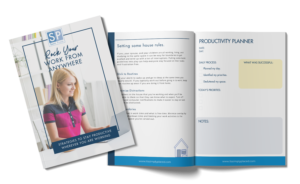
As the end of the school year approaches, it’s a good time to think about how you organize, enjoy and store school and childhood memorabilia. If you are a parent of pre-pre-school aged children you can use this time to develop ideas for a strategy for the influx of precious artwork, notes, pictures and certificates that will fill your life in the next few years. If you are a parent of pre-school or school-aged children, you may already be drowning in keepsakes or may need to refine your system for storing in order to downsize, capture the meaningful things or better enjoy what you’re keeping. Perhaps your children are grown and have left you a garage or attic full of keepsakes. You can also benefit from ideas for downsizing and ways to enjoy or pass on what you’ve collected. Wherever your are as a parent, use our strategic process for organizing your children’s keepsakes.
The Ultimate Guide for Organizing Children’s Memorabilia
Think about your goal – Having clarity on how you want to enjoy childhood memorabilia and what you want to do with it in the long term will help you identify the process and containers you need for displaying and preserving memorabilia.
Use these questions to help you get clarity on your goals:
- What do you want to get out of saving your children’s memorabilia?
- What do you want to keep? Consider keeping things that reflect a child’s development, interests and passions and things that reflect seasonal holidays.
- How do you want to enjoy it in the moment and in the future?
- Where do you want to store memorabilia and how much space do you have for storage?
- Will you need to move your collection regularly? If so, think carefully about how much you plan to save and how you will store it.
- How do you want to share the memorabilia with others (relatives and/or the grown child)?
Collecting Memorabilia – This part of the process happens daily if you have young children and less frequently as children age. The key to collecting artwork, certificates, awards, letters and any other keepsakes is to have an easily accessible container. The idea is to be able to simply put away items that you are done displaying or don’t intend to display immediately. Consider lidded under-bed boxes or an easily accessible box in a closet or home office. Establish your collection point and plan to regularly bring your keepsakes there.
Remember the details – Before you put items in your collection container, make sure to capture the details.
- Who made it, wrote it or earned it?
- When did it happen?
- What did the child have to say about it. Make notes on the back of artwork or attached a note.
- Take a picture of the child with the artwork or award.
These details, especially what the child had to say about the work or award, are often what families cherish most and the ones that quickly fade with time.
Displaying Memorabilia – Sometimes you may choose to display artwork and awards before you bring them to your collection site. Other times you may choose to display afterwards. When considering ways to display childhood memorabilia think about where and how you want to display it.
Ideas for how to display children’s artwork:
- Frames – Consider creating a gallery wall with a collection of frames which allow you to easily change pictures in and out. Often children’s art is 3-dimensional, you might consider including a shadow box.
- Bulletin boards – Include a cork or magnetic board in children’s rooms or in a common space to display a changing collection of artwork.
- Hangers – Clips hung along a wire or clothesline make changing the display quick and easy.
Caution! The key to not making a display of children’s art look cluttered and to prevent it from taking over the house is to have a specific place to display art and to regularly remove and replace what you display. The nice things about frames, bulletin boards and hangers is that they define the space for how much you can display.
Edit your collection – While the process of collecting children’s art and schoolwork is a day-to-day activity, there needs to be a periodic effort to edit the collection to reduce it’s size and to make sure what’s in the collection reflects your goals for your children’s memorabilia. It’s unrealistic to save every “treasure” your child produces and saving everything makes the collection too overwhelming to enjoy.
When should you edit? The end of a school semester or the end of the school year is a good time to edit your collection. Consider doing this with the child so that you can reminisce together, perhaps collect more details about the pieces you’re choosing to keep and decide what things you want to keep and how they will be stored.
Use these questions to help you and your child edit your collection:
- Does the piece show an important change in the child’s development?
- Does the piece mark an important achievement?
- Does the piece give insight to the child’s passions or interests?
- Is the piece a favorite?
- Is the piece really good?
Preserve – Once you’ve settled on what you’re going to keep, you need a way to preserve it. You can choose to keep the actual piece of art or you might instead take a picture of the artwork and let the actual item go.
Here ares some ideas for ways to preserve your collection:
- Plastic bins – Plastic, lidded storage bins are an excellent option for keeping your children’s memorabilia. For many families, a 56- to 60-quart storage bin can adequately contain 15 year’s worth of memorabilia. Make dividers for each year with a large piece of construction paper or cardboard and then stack the items from the next year on top of the previous one. If you plan on storing memorabilia in a damp place, consider purchasing archival containers with lids designed to seal out moisture.
- Notebooks or scrapbooks – These can contain the actual piece or pictures of the artwork or the child with the artwork. To best preserve paper, use pockets, protectors and mounting paper designed for archival purposes, items that are acid-free.
- Permanent display – Those pieces that you and your family truly enjoy may deserve permanent display. Display them in a way that fits with the look and feel of your home.
- Photo books – Photo books are a good way to preserve a large collection without taking up a large amount of space. Photo books are also easy to enjoy without having to pull out a storage box. Consider making a yearbook of your child and his or her creations and awards.
- Photo collages – Using pictures you’ve taken of either the artwork or the child holding the artwork, make a photo collage of the collection to either save or display.
Share – Consider sharing either your collection or items that you’re ready to let go of with others.
Here are some ideas for how you can share your children’s memorabilia:
- Photo books – Photo books make nice gifts for relatives and make sharing your children’s development and achievements easy. If you’ve created a photo book as a way of preserving memorabilia for yourself, consider making additional copies available to friends and relatives.
- Stationary – When you’re ready to let a piece of art go, consider using the back of it as a piece of stationary for a letter to grandma or a friend. It’s novel and a fun way to share the joy of children’s art. Another way to create stationary is by taking a picture of a piece of artwork and printing it on a note- or postcard.
- Gift wrap – Larger pieces of art can make interesting and unique gift wrap.
- Calendar – Enjoy seasonal artwork in the future by creating a decorative wall calendar.
Keeping memorabilia shouldn’t be a burden and with this process for organizing and managing children’s memorabilia it won’t be. Taking some time to think about your goals and then making time to collect and make decisions about what you’re keeping will help you manage the volume of things children create and to better enjoy those things now and in the future.
Need more ideas or support? We regularly work with clients to help them organize children’s memorabilia. Contact us to talk about your specific questions or needs.






